Lemon trees bring a touch of Mediterranean charm to any home garden, with their vibrant evergreen leaves and fragrant blossoms. And I love having lemons on hand to easily add to a salad dressing and other dishes! Despite being resilient, lemon trees can be prone to several problems that can cause them to wither and die.
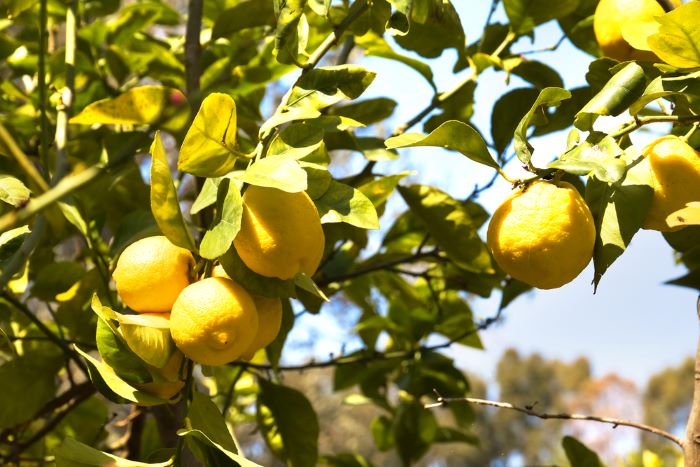
Related: How To Grow A Lemon Tree | Why Is My Lemon Bitter?
Table of Contents
Why is My Lemon Tree Dying?
The most likely reasons your lemon tree is dying are watering issues, temperature stress, a lack of soil nutrients, over-fertilization, and various pests and diseases. A lack of pruning can also contribute to an unhealthy lemon tree.
If your lemon tree is dying or showing telltale signs of decline, read on to find out why and how to fix it!
1. Watering Issues
Watering issues are the most common cause of a dying lemon tree. Overwatering and underwatering can have detrimental effects on the health and vitality of your lemon tree and can lead to its death. So, let’s take a look at the symptoms of each and how to fix it.
Overwatering
If the leaves of your lemon tree are starting to turn yellow and begin to drop you may be overwatering your tree. Another sign that your lemon tree has been overwatered is weak branches that will break from the weight of the fruit.
Overwatering is easy to do, and something we have all done! To check if the cause behind your dying lemon tree is overwatering, feel the soil. If it is wet you have been over-watering your tree.
Overwatering your lemon tree can cause an array of issues. Including providing the perfect environment for fungus and bacteria to thrive. If this is the case, you will notice small, white, or black spots on the leaves of your tree.
Additionally, waterlogged soil leads to waterlogged roots. This in turn leads to a disease called root rot, which turns the roots of your lemon tree into black sludge. This means your tree will not be able to absorb the nutrients it needs from the soil.
How to Fix it: Firstly, stop watering your lemon tree, you will need to allow the soil to dry out. Once the soil is dry when you put your finger in it, you can resume watering. Depending on rainfall and temperature, you should water your lemon tree once a week and less often during the colder months.
Underwatering
Underwatering means that your lemon tree is not getting the amount of water it needs to thrive. Lemon trees do best in warm weather, but that doesn’t mean they are drought resistant, nor do they do well if they are underwatered.
If your lemon tree is not getting enough water the leaves will become dry and brittle and will begin to drop off. The fruits on your lemon tree will also be much smaller than they should be.
How to Fix it: To fix underwatering, simply adjust your watering schedule. If the soil around your lemon tree is dry, then you should water it. The general rule is to water your tree once a week, increasing to twice a week during warmer weather. However, do not water your lemon tree if the soil is still wet.
2. Temperature Stress
Another reason your lemon tree is dying could be due to the stress caused by extreme temperatures. Both extreme hot and cold conditions can cause your lemon tree to die.
Lemon trees typically love a Mediterranean climate and grow best in temperatures ranging between 70 and 85 °F (21-30 °C) with mild winters. Establised lemon trees are tolerant of some temperature fluctuations but extemems in temperature for extended periods of time will negatively affect growth. For example, temperatures regularly reaching 104 °F (40 °C) or dipping below 30 °F (-1 °C) will stree your tree.
Too Cold
Lemon trees hate the cold, and cannot survive in temperatures lower than 30 °F (-1 °C) for long. Signs that your lemon tree is dying due to the cold are yellowing on the veins of the leaves and wilting.
The leaves of your tree may also begin to die back, turning brown and brittle. The dead leaves open your tree up to infections which can quickly spread.
How to Fix it: If your lemon tree is being affected by cold weather, you should cover it with a frost cover or burlap. Make sure it covers the entire tree to the ground. Preferably this should be done before the cold snap hits.
If you know the temperature will drop significantly, water the ground around your tree to ensure it gets enough water before the weather turns.
Too Hot
Extreme heat can be just as damaging to your lemon tree. If your tree is exposed to temperatures above 104 °F (40 °C) for long periods, it will start to die. Symptoms that your tree is dying due to heat stress are curling leaves, which will eventually turn brown.
How to Fix it: If your lemon tree is experiencing extreme heat stress, cover it with a shade cloth and water in the early morning. I’ve found mulching the ground around my lemon tree helps with water retention during the warmer months.
3. Lack of Soil Nutrients
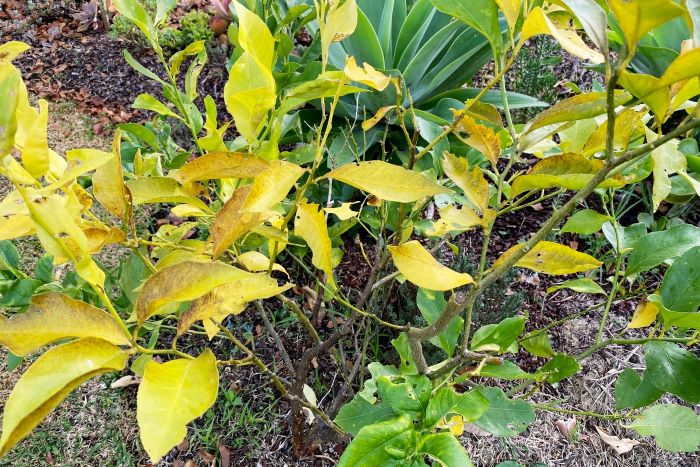
A lack of nutrients in the soil can have severe effects on the growth and health of your lemon tree. Eventually, a severe nutrient deficiency will result in the death of your lemon tree.
If your lemon tree is dying due to a nutrient deficiency, the first thing you will notice is yellowing leaves. This is a sure sign that something is not right with your tree. A nutrient deficiency manifests with leaf discoloration, the pattern and color of which depend on which nutrient is lacking. The most common nutrient deficiencies in a lemon tree are nitrogen and iron.
The soil pH level plays a vital role in the availability of nutrients in the soil. If the soil pH level is too high or too low, your lemon tree will not be able to get the nutrients it needs. Lemon trees prefer a soil pH level of between 5.5 and 6.5. To check what your soil pH levels are, use a soil testing gauge.
How to Fix it: If your lemon tree is not getting enough nutrients, the best way to fix it is to apply fertilizer. Lemon trees should be fertilized 3 to 4 times per year (with a break during winter). Often a good fertilizer NPK ratio for lemon trees is 2-1-1 or 2-1-1. A couple of organic citrus fertilizers I really like are this one from this citrus fertilizer with a ratio of 6-3-3 and this organic fruit and citrus fertilizer.
If you tested your soil and found the soil pH level too alkaline (over 6.5) you can add sulfur or soil acidifer to the soil. If the soil is too acidic (below 5.5) add limestone. I also find regular additions of compost to the soil will give it the right balance.
4. Over-Fertilization
While fertilizer is essential for providing nutrients to lemon trees, excessive or improper use can have adverse effects. Instead of helping your lemon tree to grow, too much fertilizer can cause your tree to die.
When your lemon tree has been fed too much fertilizer it will start showing signs of fertilizer burn. This means that the edges of the leaves will turn brown, making them look burnt. It is not just the leaves of your tree that will be burnt by the excess fertilizer, but the roots too.
Root burn means that your lemon tree can not absorb the correct amount of water and nutrients it needs and will begin to die.
Younger lemon trees that have not yet had a chance to establish themselves are the most at risk of overfertilization. This is in part due to us gardeners being overly keen to ‘help’ our lemon trees and over feeding them.
How to Fix it: If you have seemingly killed your lemon tree with kindness, the first thing you need to do is stop applying fertilizer. Secondly, you will need to remove any excess fertilizer from the soil. You can remove any fertilizer that you can see by hand.
Once you have removed all visible fertilizer from the top of the soil, you will need to thoroughly soak the soil to flush the rest out. A good tip here is to water the soil in the early morning to make sure the soil has enough time to dry out throughout the day.
5. Pests
Lemon trees, like any other trees and plants, are vulnerable to various pests that can potentially cause harm and even lead to the death of your tree if left unchecked.
The most destructive pests that could be attacking your lemon tree are aphids, soft scales, and citrus leafminers.
Aphids
Aphids are tiny, soft-bodied insects that like to hang out on the underside of the leaves of your lemon tree. They can be black (most commonly associated with citrus trees), green, white, or pink.
If your lemon tree is being eaten by sap-sucking aphids, your tree’s leaves will curl and develop sooty mold. The sooty mold develops because of the sticky, sweet secretion made by the aphids, called honeydew. This sticky substance attracts ants, so keep an eye out for ants on your lemon tree, they are a sure signal that you have aphids.
How to Fix it: The first thing to do when you discover aphids on your lemon tree, is to blast your tree with cold water to dislodge them. Once you have removed the aphids, apply a mixture of dishwashing liquid and water. This simple solution should be applied every 2-3 days for at least 2 weeks, to keep aphids from attacking your tree. Alternativley you can buy insecticidal soap which effectively does the job of dishwashing liquid and water.
Soft Scales

Another pest that can cause the development of sooty mold on your tree is soft scales, which like aphids, secrete a sticky substance.
They are slightly easier to spot than aphids as they are slightly larger, measuring up to 0.15 inches (4 mm). They are soft, flat, pale brown insects that congregate on the leaves, twigs, and stems of your lemon tree.
If soft scales are the cause of your dying lemon tree, the leaves and fruit on your tree will eventually drop.
How to Fix it: You can remove the leaves and twigs where the scales are present, by blasting your tree with water. Once there are no soft scales left on your tree, you can spray it with neem oil.
Citrus Leaf Miners
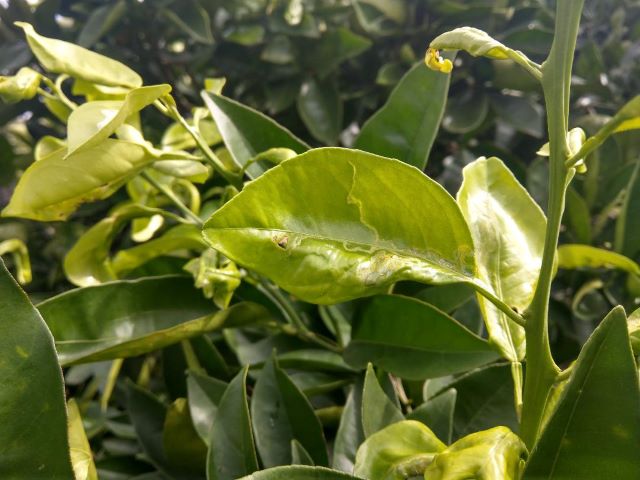
If citrus leaf miners are munching on your lemon tree, you will see winding white trails on the leaves, which will also start to discolor and twist out of shape. The damage is done by the larvae of a moth, which lays its eggs on the leaf.
How to Fix it: If you have noticed a thin, winding, white trail on the leaves of your lemon tree, remove the affected leaves. After you have removed the infected leaves, spray your tree with neem oil. You can find more details in our article on citrus leaf miner control here.
Related: How to remove Stink Bugs From Citrus Trees
6. Diseases
Lemon trees can be affected by viral, bacterial, and fungal infections that can severely harm or kill them. Each disease presents differently so it is important to identify what it is that is affecting your tree.
The most common and devastating diseases to watch out for are citrus canker, greasy spot fungus, and anthracnose.
Citrus Canker
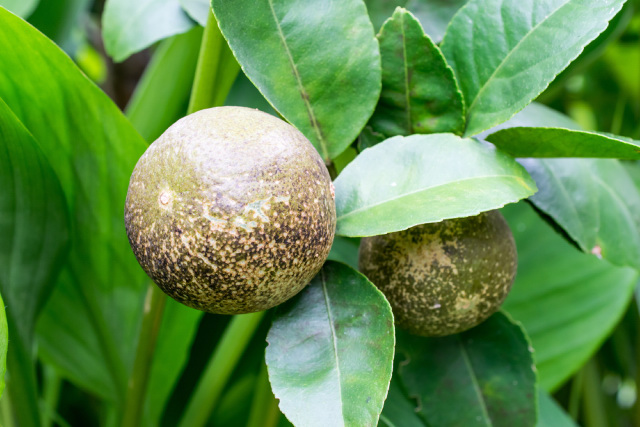
Citrus canker is caused by the Xanthomonas bacteria which can infect your plant through the damage caused to your tree by citrus leafminers.
Citrus canker presents with raised, brown and black lesions on the leaves, and fruit of your lemon tree. The twigs and stalks of your tree will develop similar symptoms. Unripe fruit will drop along with the leaves of your tree. The infected areas of the tree will eventually die.
How to Fix it: If your lemon tree is riddled with citrus canker, there is no way to salvage your tree, you will have to dispose of it. It is a highly contagious disease that is spread through wind and water droplets.
If the disease is in its early stages, you can prune the infected leaves, twigs, and stalks. The disease can also be controlled through the use of windbreakers.
Greasy Spot Fungus
Greasy spot fungus is caused by the Mycosphaerella citri fungus, the spores of which are airborne and grow on decomposing leaves.
Greasy spot fungus presents with yellowish-brown blisters on the underside of your lemon tree’s leaves. The spots will eventually turn black and start to look oily. The infected leaves will begin to drop off and eventually, your lemon tree will die.
How to Fix it: Luckily this fungus can be treated using a copper fungicide, which is the best organic option available. The great thing about copper fungicide is that it will not harm your lemon tree in the process of curing it.
Anthracnose
Anthracnose is another fungal disease that will cause the leaves on your lemon tree to drop, the twigs to die back, and the discoloration of fruit. Anthracnose is caused by the fungus Colletotrichum gloeosporioides which thrives in dead leaves and twigs.
If your lemon tree has been infected with the anthracnose fungus you will see dark, wet-looking lesions on the leaves, stems, and even fruits of your plant. Shortly after the appearance of the fungus, the center of the lesion will develop pink, gelatinous spores.
How to Fix it: To treat anthracnose, apply copper fungicide and sulfur powders weekly. Alternatively, you can spray your lemon tree with neem oil every 7 days to fight the fungus.
This fungus lives in garden debris, so make sure you practice proper garden hygiene. It can be spread through water and gardening equipment so make sure you sanitize your equipment and gardening shoes.
7. Lack of Pruning
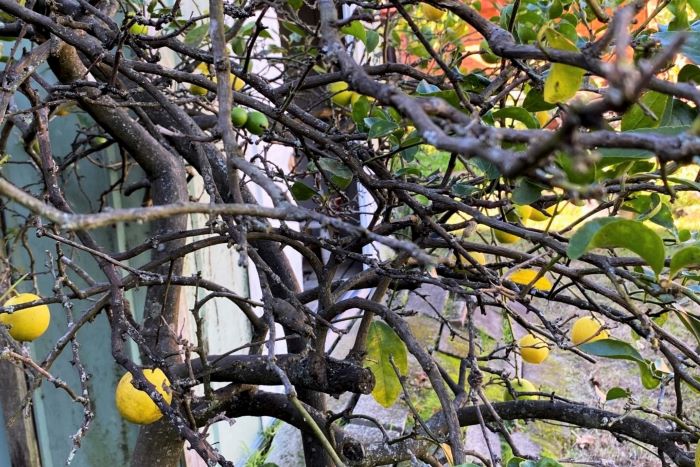
Although a lack of pruning won’t usually end in a dying lemon tree, pruning is important for the tree’s health, shape, and fruit production. Regular pruning also promotes new growth so you can expect more lemons!
And actually, giving a good prune to a seemingly dying lemon tree can be just what’s needed to revive it.
I prune my lemon tree in late winter or early spring before the new growth starts. This allows the lemon tree to recover from pruning before entering its active growth phase.
You should always use clean and sharp pruning tools, such as pruning shears or loppers, to make clean cuts without damaging the tree. Well sanitized equipment will also stop the risk of any diseases spreading from one tree to another.
The first things to prune are any dead, diseased, or damaged lemon tree branches. This helps prevent the spread of diseases and promotes overall tree health.
Then look for branches that are crossing or rubbing against each other. Choose the weaker or less productive branch to remove, allowing more sunlight and air circulation around the canopy.
Lemon trees are often pruned into a vase or open-center shape. This involves removing the central, vertical branches to encourage outward growth and an open structure. Keep an eye out for new upright shoots and prune them back to maintain the desired shape.
Remove any suckers from the rootstock below the graft union.
Finally, if your lemon tree is getting too large for its space, you can selectively prune back branches to manage its size. However, avoid excessive pruning that removes too much foliage, as it can negatively impact fruit production. I wouldn’t take off more than 20 percent to ensure you have a great lemon harvest!
